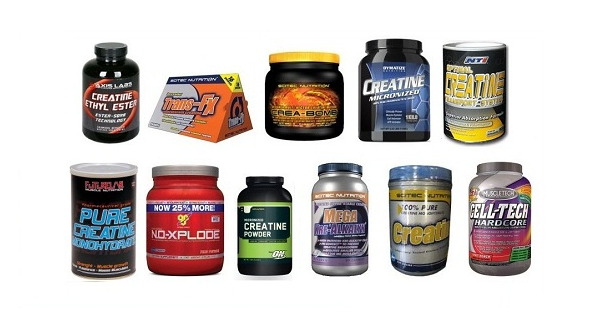In 1994 Bill Clinton signed the Dietary Supplement Health and Education Act (DSHEA) in the USA. This act essentially meant that the Food and Drug Administration (FDA) would stop regulating supplements, passing the responsibility on to the supplement manufacturers instead.
For this reason the supplement companies of today focus more on marketing to trying and differentiate their products from others than they do on expensive scientific testing. The result is thousands of products reported to be the best on the market, sometimes with little or no research backing up these claims.
Creatine is a great example of this. There are now many different types, from creatine monohydrate, creatine HCL and creatine ethyl ester to creatine nitrate. It’s also sold in many different forms, such as liquid or micronized creatine.
As we discussed in part one of this series however, creatine is a simple molecule that sits in the muscle to provide energy for high intensity contractions. Considering its simplicity, why are there so many types? What’s the difference between each one, and which one should you be taking?

For such a simple molecule, why are there so many types of creatine on the market? Marketing is king in the supplement industry and the rise of so many creatine types is simply a result of companies trying to differentiate themselves from the competition.
Properties of the Creatine Molecule
Creatine is a simple, but slightly unstable molecule that, like a magnet, will bind to anything—from water to an acid—to help make it more stable. To keep creatine stable in a powdered supplement form, it needs to bind to something until it gets into the muscle, where it can be used.
For this reason, the different types of creatine supplements on the market are simply creatine molecules bound to different things. Here are some examples:
Creatine monohydrate: Creatine and a water molecule (strangely it still makes a powder)
Creatine HCL: hydrochloric acid bound to creatine
Creatine magnesium chelate: Creatine bound to two magnesium atoms
Creatine nitrate: Creatine bound to a nitrate ion
Creatine gluconate: Creatine bound to gluconic acid
...and so on. It’s actually pretty basic chemistry… apparently.
The linking of creatine to these other molecules theoretically gives the resulting supplement different properties, such as it gets absorbed into the gut quicker (Creatine ethyl ester), it is more easily absorbed in water (Creatine hydrochloride and creatine gluconate), or it helps with energy production (creatine malate).
It seems that supplement companies, in their search to differentiate their brand, have ample opportunity to alter creatine in order to improve the product.

Creatine monohydrate, as used in Blonyx products, is by far the most researched form of creatine.. but is it the best?
Creatine Monohydrate - the gold standard
As we found out in part two of this series, Creatine was first marketed as a supplement by a company called EAS in 1993, after it was researched and discovered beneficial. This first creatine form was creatine monohydrate.
During the following decades, creatine monohydrate has continued to be extensively researched by various research labs and institutes. Scientists have studied creatine’s role in athletic performance, in human health and in disease. The research has consistently showed without question that taking creatine monohydrate at a dosage of 3-5g/day will increase strength and muscle mass with heavy training.
The power of creatine marketing and the other creatine forms
Since it’s such a well-studied product for strength training, it’s no surprise there are literally hundreds of creatine monohydrate products on the market today. And it comes as no surprise that a supplement brand would try to differentiate itself from other brands by making and selling an entirely new and improved creatine type.
Most creatine products look similar on the outside, but creatine monohydrate has by far the most established research record and, to date, no other form of creatine has been shown to be better at improving performance.
Compared to creatine monohydrate, though, there is considerably less research backing other forms of creatine. While creatine monohydrate is backed by hundreds of studies, the others boast only one or two at best.
In addition, research rarely backs up the marketing claims various supplement companies make. Creatine ethyl ester, for example, is marketed as being more easily absorbed and being a longer lasting form of creatine, yet an independent study suggested that it is actually less stable than creatine monohydrate, and likely not as good.
In fact, at the time of writing this, it seems that no other form of creatine has actually been shown to be better at improving performance than creatine monohydrate. In 2011, a group of scientists got together and investigated all the different types of creatine, and concluded, “There is little to no evidence that any of the newer forms of creatine are more effective and/or safer than [creatine monohydrate].”
This same group also reported concern that some forms of creatine could also be dangerous, and that the lack of safety data is worrying.
Now it must be noted that even though today’s research doesn’t back these new forms of creatine as being better than creatine monohydrate, there is the possibility that one or two of them are. We just don’t have any proof of this yet.
Types of creatine monohydrate that are available
Interestingly, creatine monohydrate is not only the most researched form of creatine available, it’s also the cheapest, with prices as low as $10 for a month’s supply. In their constant search for ways to stand out - and charge more, supplement companies have even engineered creatine monohydrate in order to make a better form of it.
Creapure
An example of this is Creapure® a creatine monohydrate made in Germany, that, like a good German car, is manufactured to be of the highest quality. However, as we will find out in the next part of this series, high quality creatine—which is 99.8%+ pure and manufactured in China—has become a commodity all supplement companies can easily get hold of today. The manufacturing process seems to have caught up with Creapure.
Micronized and Effervescent Creatine
Another way of differentiating creatine monohydrate is in how it dissolves in your shake/juice/water. Micronized (simply the same powder milled into a smaller powder particle size) and effervescent (fizzes up in liquid) creatine monohydrate are examples of this. Both have their merit, but in general, high purity creatine dissolves in liquid naturally and easily. Here is an example of normal high quality creatine, mixed with HMB, dissolving in coffee.
How to see past the marketing
The other creatine forms will always sell, as people are always desperately searching for improved performance gains. And supplement companies will continue to take advantage of the FDA turning a blind eye to their marketing practices.
The best way to look past the marketing hype is to do your own research. A great way to do this is to search the government-run PubMed research database, which holds the majority of research conducted on all forms of creatine. Another alternative is to use a reputable brand of simple creatine monohydrate. You’ll know it works and is a little easier on the bank balance. At Blonyx, we will never promote the creatine monohydrate we use as being better than any other brand, because we feel it would be fraudulent marketing. Our HMB+Creatine product is as true to the research as we can get and we feel that's what matters. To see why we add HMB, click here.
Here are links to all parts of this series:
Part 1: An introduction for layman
Part 2: Creatine’s history, it’s research record and it’s known side effects.
Part 3: Types of Creatine, which are the best, and are any dangerous?
Part 4: Making and marketing creatine supplements
Part 5: The myths and truths about creatine


